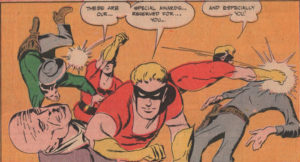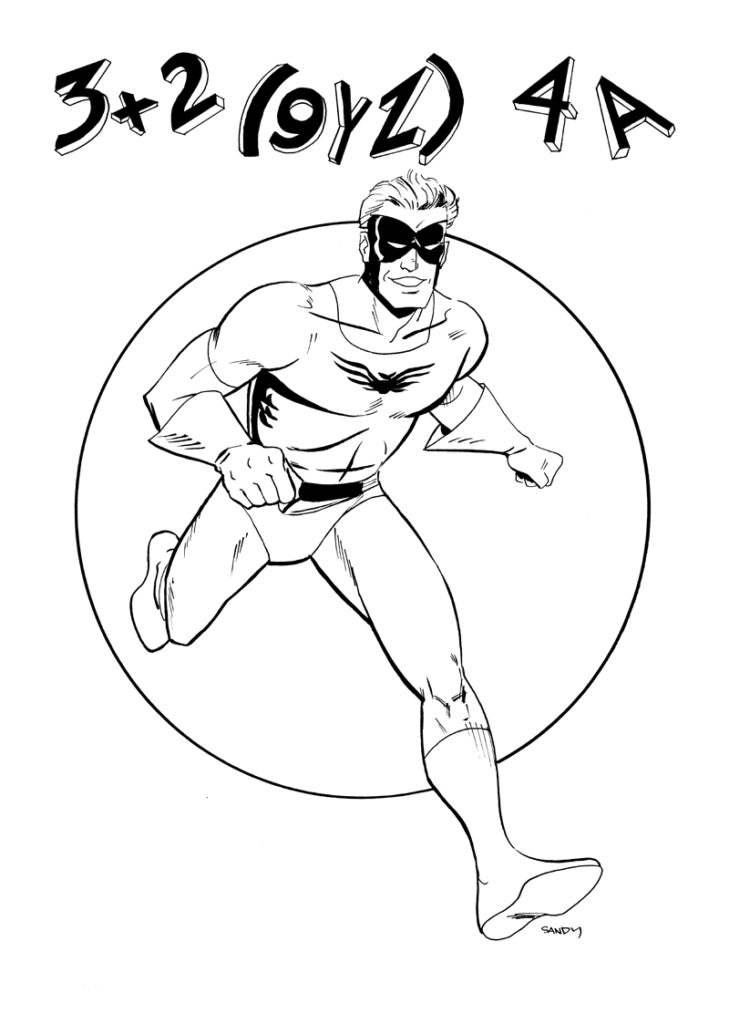Created by Mort Weisinger and debuting in More Fun Comics #71 (1941, less than two years after Flash Comics #1), Johnny Quick and his “3X2(9YZ)4A” speed formula enjoyed a 13-year run between More Fun and Adventure Comics. He even outlasted the Jay Garrick Flash, staying in publication in solo stories through 1954. A speedster who occasionally took to the skies, his secret ID of Johnny Chambers was a newsreel photographer.
Between 1941 and 1948, the artist behind the majority of Johnny Quick’s adventures was Mort Meskin. Sometimes listed as Mort Morton, Jr., Meskin is credited on 57 Johnny Quick stories, according to DCIndexes.com. DC reprinted six of those stories between three issues of the 1956-1985 Flash series, a separate Flash 100-Page Giant, an issue of Most Dangerous Villains, and a 2001 “Millennium Edition” reprint of More Fun #101.
Meskin’s portrayal of super-speed has a fluidity and grace that I was not familiar with from the two Golden Age Flash series. An unmistakable energy and powerful composition, matched with a rare depth (he was a master of chiaroscuro) and easy beauty, sets Meskin’s speedster art apart. This is not to mention his highly-regarded work outside of Johnny Quick stories, including classics that feature the likes of The Vigilante.
Longtime Flash readers will certainly remember Johnny Quick from his major supporting role during Mark Waid’s time writing the series. Fans of DC Comics from the 1980s will also recognize him from the All-Star Squadron title, which featured stories starring the Justice Society of America and their contemporaries. Prior to that, the character disappeared from new stories for 24 years before returning in 1978’s DC Special Series #11 (The Flash Spectacular).
Due to the scarcity of original issues and few reprints, experiencing the Golden Age Johnny Quick has always felt beyond my reach. I’d only read a couple of reprints via collecting Flash and was not familiar with the character beyond his appearances from 1978 onward.
Eisner-nominated comic book artist Sandy Jarrell, who has worked on titles like Batman ’66, DC Bombshells and Black Canary, has uploaded seven of Meskin’s Johnny Quick stories to his website. They can be viewed at the links below. Between Jarrell’s scans and DC reprints, fans can read a little over 20% of Meskin’s Johnny Quick work outside of the original issues. Mort Meskin’s son Peter has even reached out to Jarrell to thank him for sharing his father’s work.
More Fun Comics # 86 (Dec. 1942)
More Fun Comics # 91 (May/June 1943)
More Fun Comics # 92 (July/Aug. 1943)
More Fun Comics # 93 (Sept./Oct. 1943)
More Fun Comics # 94 (Nov./Dec. 1943)
More Fun Comics # 97 (May/June 1944)
More Fun Comics # 102 (March/April 1945)
Also, re-presented for the first time, Jarrell has provided Speed Force with scans of the Johnny Quick story in More Fun Comics #100 (Nov./Dec. 1944)!
Check out this table for a breakdown of all of Meskin’s Johnny Quick work! He was inducted into the Will Eisner Hall of Fame in 2013 and you can read Jarrell’s comments on that here. You can also check out all of the Mort Meskin stories that Sandy Jarrell has uploaded, JQ and otherwise, here.
Visit MortMeskin.net too, for biographical info and more artwork! There are also two books celebrating Meskin, published by Fantagraphics, Out Of The Shadows and From Shadow To Light.
And last, but certainly not least, is a Johnny Quick piece by Sandy Jarrell himself!
Thanks for reading!




I was hoping the Flash show would somehow work this formula into the show when Zoom kept talking about the Velocity-9 formula.
I was hoping Quick’s formula would get mentioned on the Flash show.
They DID.
In the episode where Barry goes back in time to help with his speed calculations from Eobard Thawne, the formula that Thawne gives him contains the term “3×2(9yz)4a” repeatedly and prominently.
It’s the heart of that ‘speed formula’.
Holy crap, you’re right! I’d never noticed that before! Good eye, and thanks for the heads-up!
http://i.imgur.com/z1n9UoK.jpg
I really appreciate the energy and sheer wackiness of the Golden Age. Back when the genre conventions were still settling out, you’d get everything from old-style melodrama and vaudeville through pulp crime, war, or full-on supervillain battles.
Nice to see that the one-man team subgenre isn’t limited to the Flash, either!
A lot of the other Golden Age JQ stories I’ve read recently have him doing the one-man thing, too, like learning all the instruments and performing as a one-man orchestra.
I also love how Tubby Watts is pretty much Johnny’s hype man! There’s a great sense of humor in the writing and in Meskin’s art.
Wow, that’s an amazing sketch! Great acquisition 🙂
Thanks for posting these golden age stories!
I did like Johnny Quick from the few Flash stories and 10-issue Justice Society comic of the 1990s.
It’s a shame so much of this golden age material has never been reprinted.
In my collection, the only golden age Johnny Quick story I have is the clock story reprinted in the Greatest Golden Age stories DC hardcover.
IMHO, the art IS better in the Johnny Quick stories than the vast majority of Golden Age Flash stories.
Still, I like both characters.
The Jay Garrick Flash, btw, was the speedster of choice in the last great Batman/DC animated TV series, The Brave and the Bold. The wiki alleges Jay made 13 appearances during that series!
Too bad Johnny Quick and the other golden age speedsters DC owns weren’t featured but they’re just not that well-known…